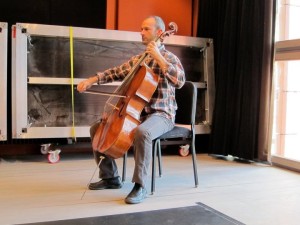Embodied Musicians
 The Alexander Technique has over a 100 year-old history of helping instrumentalists and singers to enhance performance and prevent injury. By improving the quality of the physical movements involved in playing an instrument or singing, the Technique also helps improve the quality of the music itself. A violinist’s stiff shoulders and arms will get in the way of a pleasing sound; a singer’s tight neck or jaw will cause the voice to become less resonant. By releasing undue tension in their bodies, the Alexander Technique makes possible a performance which is more fluid and lively, less tense and rigid.
The Alexander Technique has over a 100 year-old history of helping instrumentalists and singers to enhance performance and prevent injury. By improving the quality of the physical movements involved in playing an instrument or singing, the Technique also helps improve the quality of the music itself. A violinist’s stiff shoulders and arms will get in the way of a pleasing sound; a singer’s tight neck or jaw will cause the voice to become less resonant. By releasing undue tension in their bodies, the Alexander Technique makes possible a performance which is more fluid and lively, less tense and rigid.
Over the years, a number of prominent musicians have publicly endorsed the Alexander Technique: Yehudi Menuhin, Paul McCartney, Sting, Julian Bream and James Galway, to name a few. The Technique is taught at the Julliard School of Performing Arts in New York, The Royal College of Music in London, The Royal Conservatory of Music in Toronto and at many other schools of music, universities and colleges.
The EMBODIED Way for Musicians Program
Cathy Pollock is certified by the American Society for the Alexander Technique. Cathy has taught both, privately, and with groups for 20 years. Her keen observational skills and intuition offer a unique perspective to developing self-awareness. Cathy teaches musicians how to replace unwanted habits of mind and body with a freer, more spontaneous use of the self that allows self-expression and mastery of technique to be realized at the highest levels. Presentations to performing arts organizations include the Utah Symphony, the Utah Opera Company, Idaho Music Educators, the National Choral Directors Association, the National Association of Teachers of Singing, The University of Utah Vocal Arts and Piano Pedagogy Departments, Weber State University Voice and Music Education Departments, Suzuki Flute Festival classes, Utah Classical Guitar Association, The Central Oregon Symphony, and The Darens Women’s Balkan Choir.
Stages for learning to change unwanted habits to more effective activities using the Alexander Technique:
1. Observation and identification of personal patterns of use
Studying ones’ signature of movement, speech and breath
2. Moving into conscious use of the self
Learning skills that bridge the gap between noticing a harmful habit and moving into a new, improved ‘use of the self’
3. Integration.
Using the principles of the Alexander Technique at will, to breathe, move and perform with freedom, ease, intention, and improved sound production.


